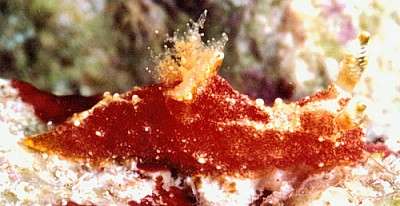Polycera from Sulawesi, Indonesia
February 1, 2000
From: Lindsay Warren


Dear Bill
I have recently returned from seven months in the Tukang Besi, SE Sulawesi, Indonesia, continuing the work of Operation Wallacea in building up a list of opisthobranch species to be found there. You may remember you kindly help us identify specimens found in 1998 and I would be most grateful if you
could help us once again. I have been able to shed light on some specimens with the literature I have access to but have drawn a blank with others. To date we have built up a list of over 320 species but there are still
many more waiting to be found there - it has been a very exciting season with invaluable help from some great volunteers who became 'committed opistho hunters'.
The first 'mystery' we believe to be a species of Plocamopherus. This was found by Graham Abbott in September in 14 m of water upside down on a patch of encrusting sponge. The overall colour is pinky red with white protruberances of varying size scattered over its body and with a line of these down the posterior dorsum behind the branchial plume.
On either side of the branchial plume is a horizontal, short, fat lobe which is a bit hard to see in the photos. The notum features a white patch. The rhinophores are lamellate with base stem and a small 'knob' on top - mottled white, pinky red and olive green - I do not remember whether they were partially or totally retractile. In the second scan you will be able to just make out the two pairs of oral tentacles - the lower set is shorter than the upper more anterior pair. From the photos I have seen of other Plocamopherus, this perhaps would not be typical as they appear to have multiple branched oral tentacles. L: 8 mm. Photo: Lindsay Warren.
What do you think this could be?
Many thanks for your help
Lindsay Warren
100014.2112@compuserve.com
Warren, L., 2000 (Feb 1) Polycera from Sulawesi, Indonesia. [Message in] Sea Slug Forum. Australian Museum, Sydney. Available from http://www.seaslugforum.net/find/1823Dear Lindsay,
Glad to hear the last year has been so successful. I look forward to seeing some more interesting animals. This does look a bit like a Plocamopherus but the relatively short 'tail' behind the gills and other external features suggest this is a species of Polycera. I can't make out your two sets of 'oral' tentacles and I am not sure that the pair I can see are oral tentacles or papillae at the mantle edge. In some species, such as Polycera capensis there are 2 or 3 pairs of these anterior papillae at the mantle edge. Oral tentacles in dorids are usually quite small and lower down. The pair of papillae flanking the gills are also typical of Polycera.
Unfortunately I don't think there is an easy name for your species. There are names around for Indo-West Pacific species but at present their identity is a bit problematic.
Best wishes,
Bill Rudman.
